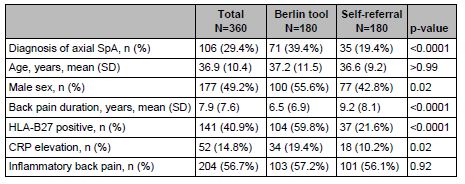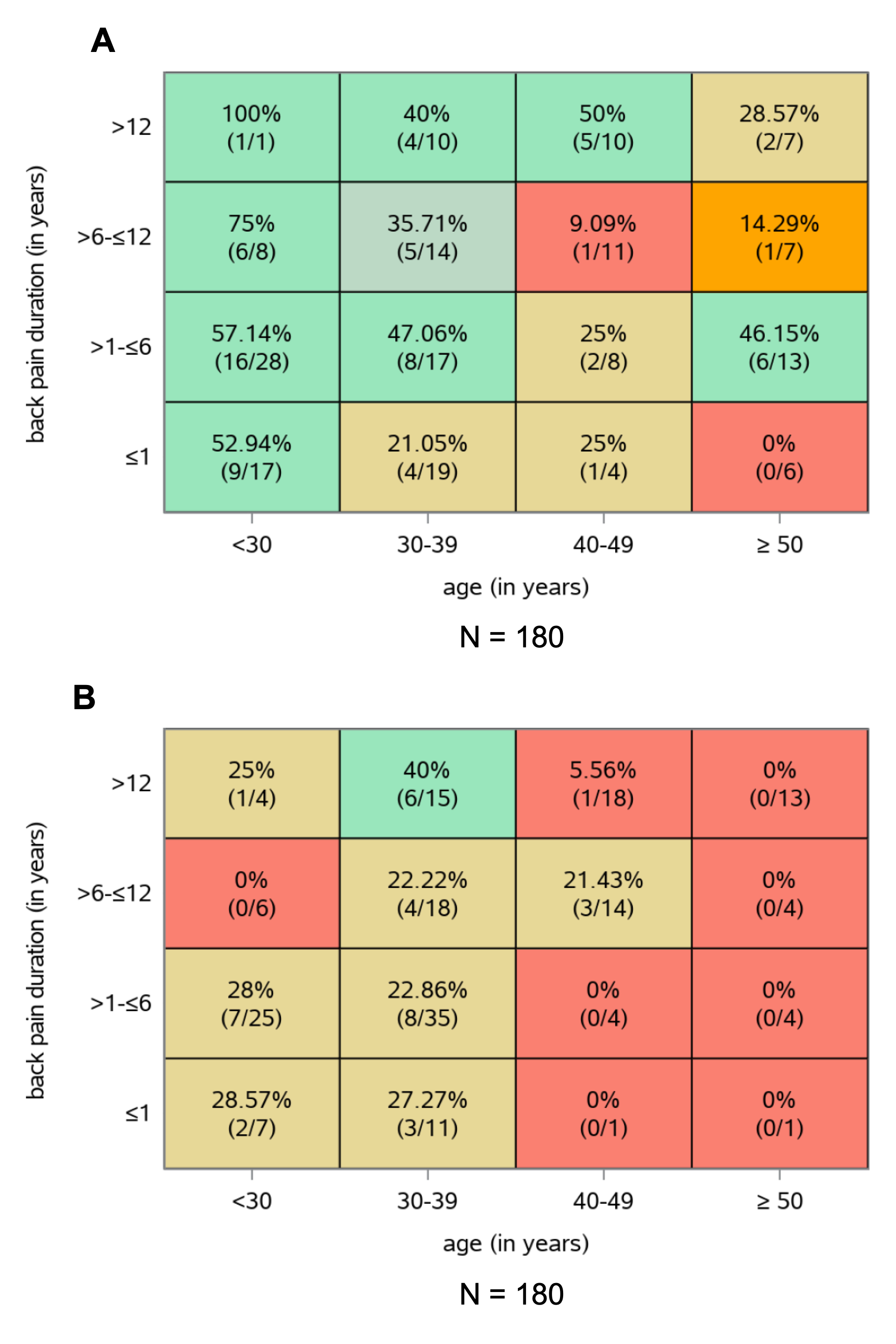Session Information
Session Type: Poster Session A
Session Time: 8:30AM-10:30AM
Background/Purpose: One of the most important prerequisites for a timely diagnosis of axial spondyloarthritis (axSpA) is the early referral of a patient with back pain to a rheumatologist. In the past years a number of referral strategies has been proposed, most of them in line with the ASAS referral recommendations [1] and with a similar performance – about 30-40% of the referred patients can be diagnosed with axSpA after examination by a rheumatologist. In addition to physicianbased strategies, an online self-referral (OSR) strategy has been recently proposed and evaluated about 20% of the patients being diagnosed with axSpA after rheumatologic evaluation [2]. The objective of the current analysis was to investigate the role of age and symptom duration for the optimization of a physician-based and an OSR strategy for axSpA.
Methods: In the OptiRef study, patients with chronic back pain and suspicion of axSpA either referred by primary care physicians /orthopedists using the Berlin referral tool (=physician based) or based on a referral recommendation of an OSR were evaluated by rheumatologists in a specialized center [2]. All patients underwent a structured examination including imaging that resulted into the final diagnosis of axSpA or no axSpA. The relationship between age, symptom duration and the likelihood of axSpA diagnosis was evaluated in this analysis.
Results: A total of 360 patients (180 presented via the OSR and 180 referred by the physician based referral strategy) were included in this analysis. Patient’s characteristics are shown in Table 1. A total of 71 patients (39.4%) in the physician-based group and 35 patients (19.4%) in the OSR group were finally diagnosed with axSpA. The heatmaps depicting the relationship between the proportions of patients diagnosed with axSpA and age plus symptom duration (Figure 1) showed a clear decline of the axSpA probability with increasing age. In the physician-referred group, however, axSpA was diagnosed even in patients who were above 50 years at the timepoint of the examination, while there were only few patients with axSpA in the self-referred group aged 40-49 years, and none in the age group ≥50 years. Interestingly, there was no clear relationship between symptom duration and probability of the diagnosis: axSpA was diagnosed in a substantial proportion of patients even with a long history of back pain ( >12 years) in both subgroups.
Conclusion: The probability of axSpA is high in patients suffering from back pain and aged < 40 years with a substantial decline thereafter. Therefore, a referral strategy based on self-evaluation of symptoms should be more focused on a younger patient population, while physician-based strategies do not require such a restriction.
References:
1. Poddubnyy D, et al. Ann Rheum Dis 2015 Aug; 74(8):1483-1487.
2. Proft F, et al. Semin Arthritis Rheum. 2020; 50(5):1015-1021.
Acknowledgements: We would like to thank all orthopaedists and primary care physicians who referred their patients. Further, we thank Dr. Anne-Katrin Weber and Dr. Susanne Lüders for the data collection support, Annegret Langdon for the data management support and Torsten Karge for set-up and support of the online screening tool.
Total
relation to age and symptom duration in the physician-based (A) and OSR (B) groups.
To cite this abstract in AMA style:
Proft F, Spiller L, Muche B, Protopopov M, Rademacher J, Rios Rodriguez V, Torgutalp M, Poddubnyy D, Redeker I. Optimizing a Referral Strategy for Patients with a High Probability of Axial Spondyloarthritis:the Role of Age and Symptom Duration [abstract]. Arthritis Rheumatol. 2021; 73 (suppl 9). https://acrabstracts.org/abstract/optimizing-a-referral-strategy-for-patients-with-a-high-probability-of-axial-spondyloarthritisthe-role-of-age-and-symptom-duration/. Accessed .« Back to ACR Convergence 2021
ACR Meeting Abstracts - https://acrabstracts.org/abstract/optimizing-a-referral-strategy-for-patients-with-a-high-probability-of-axial-spondyloarthritisthe-role-of-age-and-symptom-duration/


